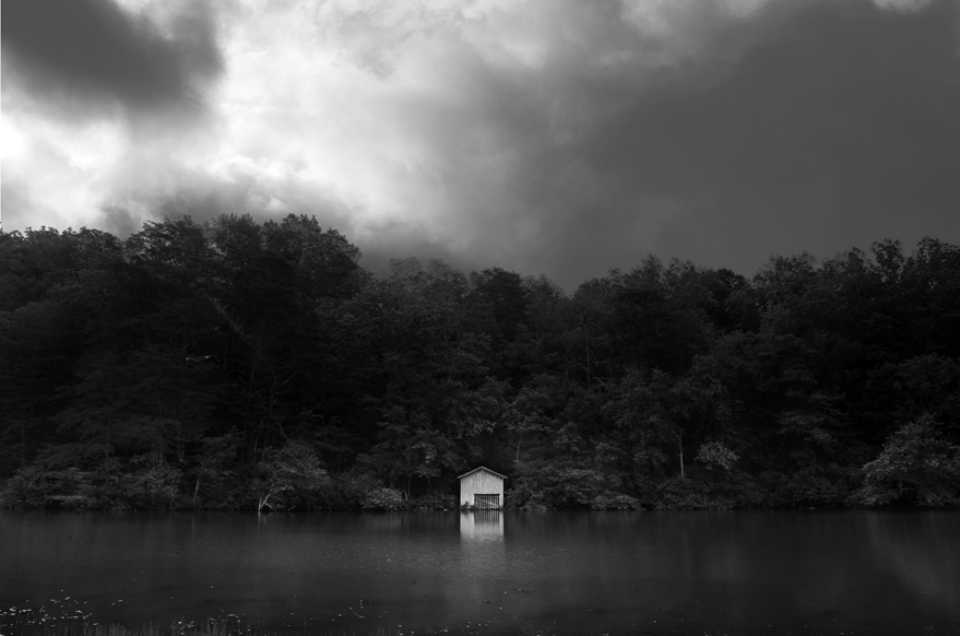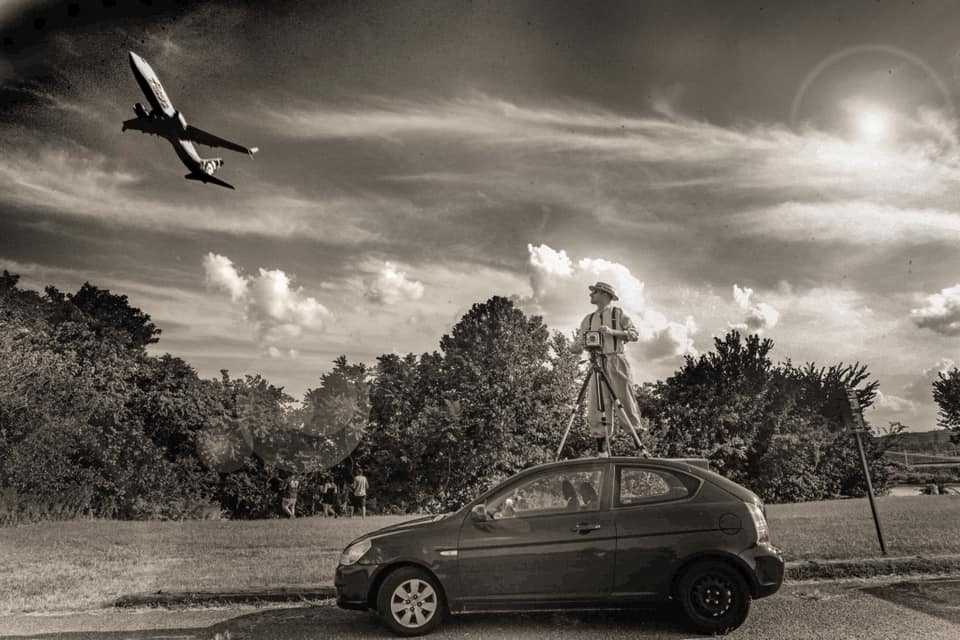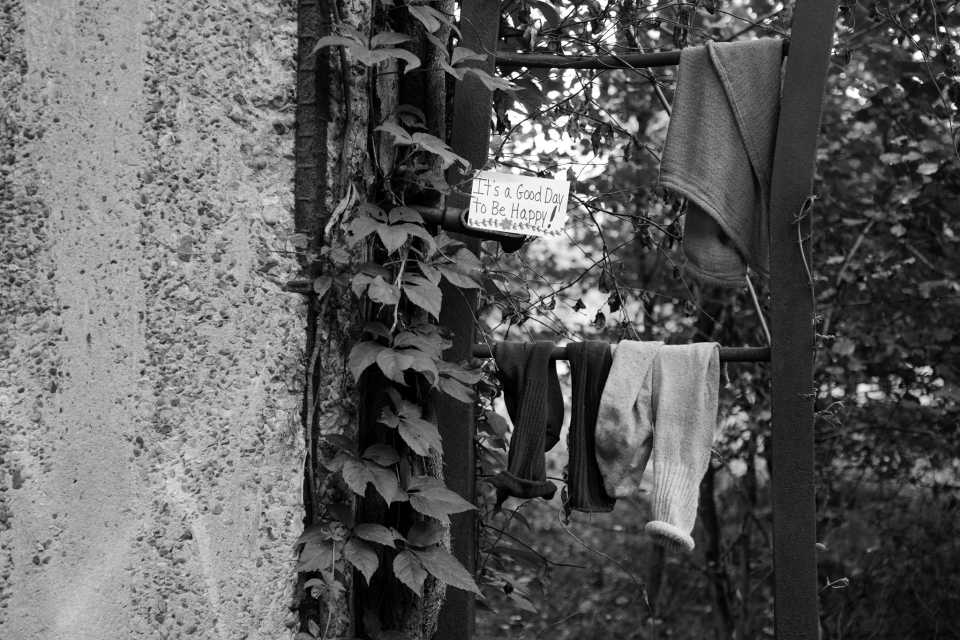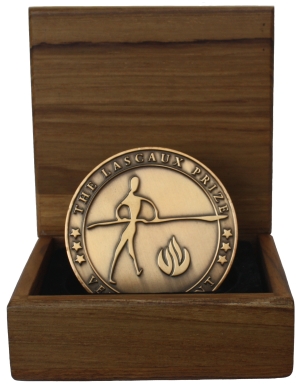
“Lumpkin County, Georgia, 2019,” photograph by B.A. Van Sise
Just after dawn in a dingy restaurant mensroom in rural Georgia, I hold my hands under an impotent faucet for a dry minute until, with a sputter, one curdle of rusty red water bolts out, and then another, pooling over the clogged drain below and smelling faintly like dried blood. Stagnant from disuse, it takes a while for the clotted air to clear the artery of pipes underneath the floor, making one wonder when any cook here last washed their hands. I count the seconds until a steady stream finally comes, growing easy and clear after about thirty Mississppis.
Next to the sink, there is a bulletin posted with advice for any sex slaves that might want to escape.
Are you or someone you know, it begins, being sold for sex? Or are you forced to work for little or no pay, and cannot leave?
The morning before, I’d nearly been carted off to jail. I’ve come down south to make photographs for my Elsewhere photo exhibition series; essentially, I show up in random places around America with an exceptionally large camera and tripod, looking a bit like the personal cameraman to Snidely Whiplash: bellows camera, black curtain over my head. I make photographs of American scenes, all of which have airplanes flying around in them somewhere. It requires a lot of rudderless ambling around the continent—long phrases of monotonous waiting for something to come together poetically, punctuated by brief moments of extreme panic as I try to catch it. On a two week trip like this, if I can make two truly good pictures, I’m ecstatic.
After seven days on the road, I am not ecstatic. I like the South. It’s America’s side porch: a great place to hang out, watch the world go by, stay dry when a rainstorm hits as you watch and whisper we needed this. And I must admit that, as long as one stays off the highways, it has its joys. For a week I’ve been humming slowly down wending roads past ramshackle lean-tos, drooping general stores, and humorless concrete churches, all set into the soil under scoliotic trees, moss hanging down, butterflies between them. The trick to finding America is to avoid it; you must steer clear of one of its most important creations, the interstate highway. It was the interstate highway system, and not any law or war, that finally united the states, but it also brought with it damp-pantsed Cracker Barrel nationalism: chain stores, bad restaurants, malaise, obesity. You can get from Los Angeles to New York in three days, and so can your french fries, but only one of you has any good reason to do so.
In a week of drifting through one meretricious village after another, I’ve rolled down old roads pocked with chuckholes so deep that you can hear China from their bottoms, past an endless litany of stores selling fireworks, whisky, or both. It’s unspeakably, cruelly hot, thick air that settles into your lungs and refuses to leave, that soaks your shirts as fast as you can don them. The air sounds like simmer, with bugs that swarm like maracas and little cracks of critters in the grass that snap like an upright bass. And the tarmac and gravel and mud have brought me here to a small town in southern Georgia, just a mile or two from the end of some runway or other, where I’m waiting for a flight to take off. The picture isn’t great, but none of them have been on this trip, and I’m sitting with my fingers crossed that one of the several meth addicts lingering on the street might do something: a drug deal, perhaps, or spontaneously break out into interpretive dance.
It’s a pretty town. You can picture it, if you’ve ever seen the south in literally any American movie: stately oaks, hanging vines, old plantation homes; its 952 people pining for their previous, there-were-gazebos Ragtime existence, with battle flags in their hope chests and shackles in their sheds.
Some eyes in some window have seen me, and found me lacking; the police have been called. What must certainly be the town’s entire police force shows up. Six guys. Three cars. Everybody’s in tactical gear. They surround me, their cruisers thundering up onto the sidewalk like they’d heard I was murdering a man.

“What are you doing here?” asks the first officer, a small, tossable man with a wen over his eye and an unusual last name that happens to match that of the street I’m on.
“I’m making photographs for a project, Officer DeLoach.”
“I see.” He glances back and forth with the other five officers, as two move behind me, and yet another perches himself in the window of the car, where Robin is sitting. “What kind of photographs?”
“I make landscape photographs of American scenes, using a unifying theme of flying aircraft to tell stories about both the unique mobility of American life, as well as the mutable everyday lives of those who remain in place.”
“Uh, sure, whatever. You know you can’t take pictures here, this is a public street.”
I try to explain to him, calmly and patiently, that I’m not a threat, and that a public street is exactly the sort of place where a photographer can make photographs. He’s friendly, but two more officers perch behind me. I show him some of the other photographs I’ve made, which to him are clearly just nice pictures of airplanes flying around.
“I’m not worried about you,” he says with a smile. “Do you got a card or something?”
I give him my card, an eccentric little token that says “B.A. Van Sise—by chance, or appointment,” and naught else, and he and another officer walk to their car and pull out their phones to google me. “Shit,” says the second one, “I think he might be famous.”
They look up at me, and back at the phone again.
Behind my back, at the car, the handsome young officer is still catbirding over the passenger window, flirting with Robin. He’s got good taste; she’s in her vacation dress: a patriotic polka dot affair, her very finest. She’s wind-swept from the drive. He asks her about our trip, and tells stories, and listens to hers, and is clearly smitten. Staring at her mouth, he keeps one hand pressed firmly inward against the door, and the other squarely on his Glock 9mm. You can see he’s ready: he’d like to fuck her, sure, but he can also shoot her in the head.
The first officer walks back to me. “Listen,” he says, “I’m gonna let you go, but next time you wanna take pictures where you’re not supposed to be, you ask permission first.” The officer pressed against Robin’s car door looks up. “We good to go?”
The first officer nods, and all the rest walk back to their cruisers, waiting in position for me to drive away.
All victims of slavery and human trafficking have rights and are protected by international, federal, and state law.
Call the National Human Trafficking Resource Center at 1-888-373-7888 for help.
One doesn’t expect slavery in the Waffle House, but apparently in a place defined for centuries not just by who they are but who they owned, it’s still a possibility. Interestingly, the abolitionists have placed no advertisement in the women’s Necessary, so any sex slave, yearning to be free, is going to have to first accidentally find their way to the gents’ and then, somehow, get their hands on a cell phone before sitting quietly and praying fiercely that the authorities can show up faster than their captor can polish off a stack of pancakes. It’s a well-meaning but flawed plan, and I can barely keep my attention on my scrambled eggs, always eye-minded and scanning the crowd for the desperate would-be fugitives, without any clear idea of what, precisely, to look for in a modern-day slave, in an age when they can be anybody.
The Federal Emergency Management Agency has a specific metric they use, called the Waffle House Index, in which they determine the true severity of a storm by the status of the Waffle House. It’s split into three categories, all based on the actual chain of restaurants, which are known for their disaster preparedness: in condition green, the Waffle House has electrical power, and the full menu is available; in condition yellow, the food supplies might be low, but generator power has kept the restaurant open; in condition red, the Waffle House has closed, and the government knows it’s truly time to act. It’s informal, but it’s real, but it doesn’t take into account other factors: what does the government do when the Waffle House cooks don’t wash their hands? Trump is in the White House and the hydrangeas are in bloom: what will the government do when the Waffle House suspects slavery in its midst?
“One more thing,” says Officer DeLoach. “Where y’all headed?”
I tell him that I don’t really have a plan; I just sort of wander around, but that I was thinking of heading west.
“Whatever you do, don’t go to Macon,” he tells me, naming a city that I confess to not having ever heard of in my life. I ask him why not.
“Well,” he leans in with a nod, “it gets real … dark around there, if you know what I mean.”
One knows an invitation when they find it. I know where to go.
Four hours later, driving around Macon, I stop in among many ruins; the city’s industry, once up-and-coming, has up and gone, leaving behind crumbling factories, warehouses, offices. Behind a railway coal plant, I find a hobo camp whose citizens have just scattered, leaving their wet laundry on lines to dry. Next to the socks, someone has mounted a happy note in a cheery hand, the sort of penmanship and message you’d expect from a third grade teacher: It’s a Good Day to Be Happy!
As I drive slowly down a Macon back road looking at the forgotten sprawl of the city’s edge, an elderly man steps out into the street next to my car. “You lost, white boy?” he yells at me, and I sputter trying to decide how existentially I want to consider the question. I fail to answer him.
That night, I sleep under the stars not far outside Macon, trying to digest the day before: the police, the ruins, the unbearable, choking heat. I remember the sign at the hobo camp: it’s a good day to be happy.
Those cheerful tramps are correct, I tell myself in the sunrise, folding up my tent and looking at my soiled hands. Only one thing to do: I’ll treat myself to a nice big breakfast at the Waffle House- get a big plate of eggs, and wash myself up. It’s a good day to be happy.

B.A. Van Sise is an author and photographic artist focused on the intersection between language and the visual image. He is the author of the visual poetry anthology Children of Grass: A Portrait of American Poetry with Mary-Louise Parker, and Invited to Life: After the Holocaust with Neil Gaiman, Mayim Bialik, and Sabrina Orah Mark. He has previously been featured in solo exhibitions at the Center for Creative Photography, the Center for Jewish History and the Museum of Jewish Heritage, as well as in group exhibitions at the Peabody Essex Museum, the Museum of Photographic Arts, the Los Angeles Center of Photography and the Whitney Museum of American Art; a number of his portraits of American poets are in the permanent collection of the Smithsonian’s National Portrait Gallery. His short nonfiction and poetry has been featured in Poets & Writers, The North American Review, Nowhere, The Los Angeles Review, The Southampton Review, and elsewhere. His poetry has previously appeared in K’in Literary Journal and The Coil, and he is a frequent reviewer of poetry and photography titles for New York Journal of Books. He is a Prix de la Photographie Paris award-winner and an Independent Book Publishers Awards gold medalist.



